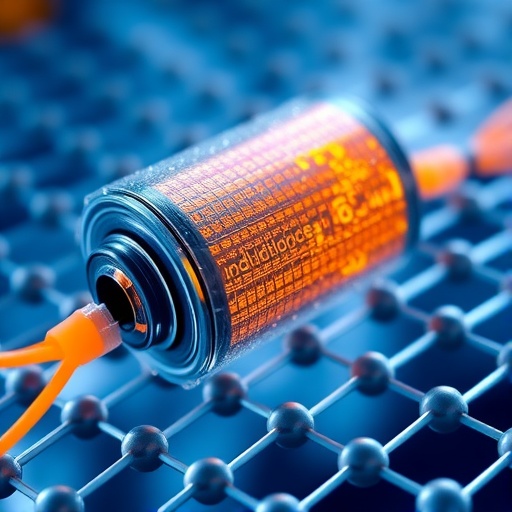The burgeoning field of electrochemically exfoliated graphene is witnessing a significant transformation, particularly in how various electrolytes influence its formation and the resultant supercapacitor performance. Researchers, led by Kirubasankar et al., have embarked on a comprehensive investigation that aims to unlock the potential of this remarkable material through innovative electrochemical techniques. The implications of their findings could reshape energy storage devices, pushing them closer to sustainable and efficient solutions that match the demands of modern technology.
Graphene, a single layer of carbon atoms arranged in a two-dimensional lattice, is celebrated for its extraordinary mechanical and electronic properties. It stands at the forefront of materials science, heralded for its strength, conductivity, and flexibility. Such traits position graphene as a vital candidate in various applications, most notably in energy storage systems like supercapacitors. However, the method of synthesis and the choice of electrolytes play critical roles in determining the quality and efficacy of the produced graphene. The research led by Kirubasankar is a testament to the importance of these factors.
In the realm of electrochemical exfoliation, the type of electrolyte used is crucial. Electrolytes can vary widely in composition, from simple salts to more complex ionic liquids. The choice of electrolyte affects not only the rate of graphene exfoliation but also the morphology and properties of the resulting graphene flakes. Kirubasankar and his team explored various electrolytic environments to determine how these conditions impact both the exfoliation process and the structural integrity of graphene.
Understanding the intricacies of electrolyte interactions with graphene during the exfoliation process is paramount. Some electrolytes may promote better dispersion of graphene flakes, leading to enhanced superscapacitor performance due to higher surface area and improved conductivity. Conversely, others may hinder this process, resulting in agglomerated graphene that does not perform as well. The researchers meticulously analyzed these interactions, aiming to provide a clearer understanding of how electrolytic composition influences material properties.
The method of electrochemical exfoliation itself is pivotal. It typically involves the application of an electric field to graphite in the presence of an electrolyte, resulting in the peeling away of graphene layers. Kirubasankar’s team conducted experiments to optimize parameters such as voltage and time duration, investigating how these factors, when combined with different electrolytes, affect the yield and quality of graphene. Their findings demonstrate a direct correlation between the optimization of these variables and the performance characteristics of the resultant graphene-supercapacitor system.
One of the most striking facets of this research is the performance assessment of graphene-based supercapacitors. These devices are essential for energy storage as they bridge the gap between batteries and traditional capacitors, offering rapid charging and discharging capabilities coupled with high cycle stability. The team conducted extensive tests to evaluate how the exfoliated graphene, when integrated into supercapacitor architecture, capitalized on its unique properties to deliver superior energy storage capabilities.
The ecological aspect of using graphene-derived materials in energy storage systems cannot be understated. Greener strategies, particularly those that utilize abundant materials like graphite and operate under benign conditions, align with global sustainability goals. Through careful selection of environmentally friendly electrolytes and optimizing the exfoliation process, this research has the potential to advance graphene technology into a more sustainable realm.
As the team disseminated their findings, they also highlighted the challenges that remain within this innovative field. Issues such as scalability of electrochemical exfoliation processes and the commercial viability of using different electrolytes for mass production of graphene must be addressed. By laying the groundwork for further research, Kirubasankar et al. invite future investigations that could potentially refine these methods, making them more accessible for commercial applications.
The implications of their research extend beyond mere academic interest; they pave the way for practical advancements in various sectors including electronics, renewable energy, and advanced materials. The exciting potential applications for electrochemically exfoliated graphene are vast, ranging from flexible electronics to enhanced drug delivery systems. As researchers delve deeper into these applications, the role of electrolytes will undoubtedly become a focal point in optimizing performance and scalability.
Innovation does not thrive in isolation. The collaboration among researchers within this area, as evidenced by the work of Kirubasankar and his colleagues, showcases how interdisciplinary dialogue and shared knowledge can culminate in transformative discoveries. With each advancement in understanding the nuances of materials chemistry and electrochemistry, the scientific community takes one step closer to unlocking the full potential of graphene and its application in next-generation energy solutions.
In conclusion, the intricate relationship between electrolytes and the electrochemical exfoliation of graphene marks a significant milestone in materials science. Kirubasankar et al. have successfully illuminated this connection, offering both foundational knowledge and practical implications for energy storage applications. As they continue to explore the depths of this fascinating field, the potential for groundbreaking developments appears boundless, inviting researchers to engage with this dynamic domain of science.
The journey towards sustainable, efficient energy solutions, underscored by the principles of graphene technology, marks not just a scientific endeavor, but a necessary stride towards a greener future. As we look forward to further investigations in this field, the work of Kirubasankar and his team provides a critical foundation for understanding and harnessing the power of electrochemically exfoliated graphene.
Subject of Research: Influence of different electrolytes on the formation of electrochemically exfoliated graphene and their supercapacitor performance.
Article Title: Influence of different electrolytes on the formation of electrochemically exfoliated graphene and their supercapacitor performance.
Article References:
Kirubasankar, B., Venugopal, P., Lee, T. et al. Influence of different electrolytes on the formation of electrochemically exfoliated graphene and their supercapacitor performance.
Ionics (2025). https://doi.org/10.1007/s11581-025-06687-2
Image Credits: AI Generated
DOI: https://doi.org/10.1007/s11581-025-06687-2
Keywords: Graphene, Electrochemically Exfoliated Graphene, Electrolytes, Supercapacitors, Energy Storage, Sustainable Technology.
Tags: electrochemical exfoliation techniqueselectrolytes in graphene exfoliationelectronic properties of grapheneenergy storage solutions with graphenegraphene synthesis methodsimpact of electrolytes on graphene qualityinnovations in materials scienceionic liquids in graphene productionKirubasankar research findingsmechanical properties of graphenesupercapacitor efficiency improvementssustainable energy storage technologies





